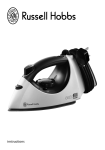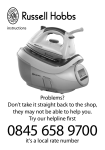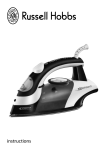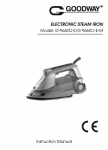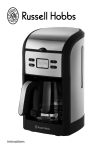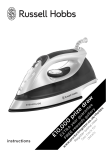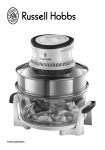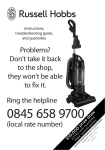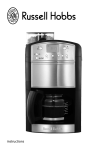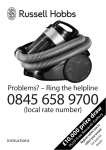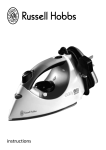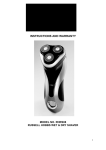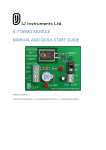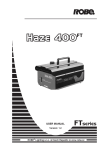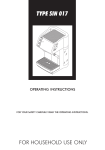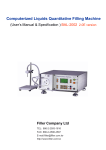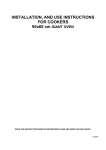Download instructions - Russell Hobbs
Transcript
instructions 2 Read the instructions and keep them safe. Pass them on if you pass the iron on. Remove all packaging, but keep it in case you ever need to return the iron. important safeguards Follow basic safety precautions, including: 1 This iron must only be used by or under the supervision of a responsible adult. Use and store it out of reach of children. 2 Don’t put the iron in liquid, don’t use it in a bathroom, near water, or outdoors. 3 Route the cable so it doesn’t overhang, and can’t be tripped over or caught. 4 Don’t iron clothing while it’s being worn – you’ll burn or scald the wearer (this is not a joke – I’ve seen it happen). 5 Don’t touch the soleplate, and keep away from the steam coming from it. 6 Don’t use the iron in the vicinity of children. 7 Sit the base unit on a stable, level, heat-resistant surface, preferably a purpose-built “steam generator” type ironing board. 8Don’t sit the base unit on a soft, carpeted, or upholstered surface, as this may block the vents underneath the base unit. 9 Don’t leave the iron unattended while plugged in, or while it’s standing on the ironing board. It could be knocked over by you, by a child, or by a pet. 10 Unplug before filling, before cleaning, and after use. 11 Don’t fill past the MAX mark on the reservoir, or water may escape in use. 12 Unplug the iron when not in use, before moving and before cleaning. Let it cool down fully before cleaning and storing away. 13 Don’t fit any attachment or accessory other than those we supply. 14 Keep the cables and steam pipe away from hot parts. 15 Keep the iron and the cable away from hotplates, hobs or burners. 16 Don’t use the iron for any purpose other than those described in these instructions. 17 Take care not to scratch the soleplate – avoid buttons, zips, etc. 18 The iron has a protective thermal fuse, which will blow if it overheats. If this happens, the iron will stop working, and must be returned for repair. 19 Don’t operate the iron if it’s dropped or damaged, or if it malfunctions or leaks. 20If the cable is damaged, return the iron, to avoid hazard. household use only remove all packaging • Remove any labels, stickers or packaging from the iron and soleplate. cure the element • Before using the iron for the first time, or if it’s not been used for a long time, iron a scrap piece of cotton (an old towel is ideal) to remove any accumulated residues. • Don’t worry if the iron smokes a bit at first, it’ll stop as the residues evaporate. 3 water 1 Use ordinary tap-water – the anti-scale cartridge will soften the water. 2 If the anti-scale cartridge needs replacing, and you don’t have a replacement, you should use distilled water while you’re waiting for the replacement to be delivered. ,Don’t use chemically descaled water, or water from a water softener – softened water can do more damage to your iron than hard water. 3 If you buy distilled water, check that it’s marketed as suitable for irons. 4 Don’t add anything to the water, and don’t use water with anything added to it. 5 When the water is converted to steam, chemicals, perfume, and other additives will coat the inside of the steam chamber, shortening the life of the iron. filling 6 Switch off before filling – press and release the iron switch and the boiler switch, then unplug the iron. 7 Remove the reservoir: a) put the fingers of one hand into the grip under the front of the reservoir b)press the catch on the top rear of the reservoir with the other hand c) pull the reservoir out of the base unit 8Fill the reservoir: d)one of the tubes in the rear of the reservoir has a MAX mark inside e) pour water into the other tube f) fill the reservoir up to the MAX mark (about 800ml) g)don’t fill past MAX, or water may escape in use 9 Replace the reservoir: h)slide the reservoir into the base unit i) check that the catch on the reservoir clicks into place in the base unit j) prime the iron before use – see below switch on 10 Sit the iron on the heatproof stand on top of the base unit. 11 Put the plug into the power socket (switch the socket on, if it’s switchable). 12 Press and release the boiler switch, then the iron switch. 13 The boiler and iron lights will glow. 14 When the boiler is ready to generate steam (2-3 minutes), the steam ready light will glow. 15 It’ll then cycle on and off as the boiler works to maintain the temperature. 16 If the temperature control on the iron is set above room temperature, the thermostat light on the iron will glow, to show that the soleplate is heating up. 17 It’ll go out when the soleplate reaches the temperature set by the temperature control, then cycle on and off, as the thermostat works to maintain the temperature. priming 18 Prime the iron after filling the reservoir, to get water and steam through the system. 19 Hold the iron below the level of the base unit, and press the steam button, on top of the iron. 20You’ll hear the pump as it pushes water through the system, then, after 30 seconds or so, it’ll start to quieten, and steam will come out of the soleplate. 4 21The iron is now primed and ready for use. preparation 22Check for textile care symbols (i j k l). 23Iron fabrics needing low temperatures j first, then those that need medium temperatures k, and finish with those needing high temperatures l (or max). set the temperature 24Turn the temperature control to bring the setting you require next to the mark. temperature setting guide label marking temperature setting j cool – nylon, acrylics, polyester • k warm – wool, polyester mixtures •• l hot – cotton, linen ••• denim/jeans MAX i do not iron ,If the instructions on the fabric label differ from this guide, follow the instructions on the label. 25If the soleplate is at a lower temperature that the one you’ve set, the thermostat light on top of the iron will glow, to let you know that the soleplate is heating up. 26When the soleplate reaches operating temperature, the thermostat light will go out, then cycle on and off as the thermostat works to maintain the temperature ,If you want to use steam, set the temperature to S or higher, or you may get water. steam ironing 27Set the temperature control to S or higher – otherwise the steam might condense on the soleplate, giving you water, instead of steam. ,When you first want steam, you must prime the pump (page 4). 28Press the steam button on top of the iron to produce steam, release it to stop the steam. 29Don’t let the reservoir empty in use, or you’ll have to prime it again when you refill it. ,Steam may still escape from the iron after you release the steam button. This is normal, don’t worry about it. constant steam 30For a constant stream of steam, press the steam button, then slide the latch (on the rear of the button) back, towards the rear of the iron, to lock the button down. 31Slide the latch forward, to unlock it, and revert to normal use. 5 dry ironing 32You can dry iron by just not pressing the steam button, but if you want to make sure you don’t press it accidentally, then you should iron with an empty reservoir. 33Do your dry ironing first, then switch off, fill the reservoir, and do your steam ironing. vertical steaming 34Remove wrinkles from hanging clothes, hanging curtains, and furnishing fabrics. 35Check that there’s adequate ventilation behind the fabric, otherwise moisture may build up, causing mildew. 36Check that there’s nothing behind the fabric that may be damaged by the steam. 37Check that pockets, turn-ups, and cuffs are empty. 38Check that there’s water in the reservoir. 39Check that the temperature control is at or higher. 40Wait till the thermostat light goes out, then start steaming. 41Hold the iron close to (but not touching) the fabric. ,Hold it well away for delicate fabrics. 42Press the steam button to produce steam, release it to stop the steam. no water 43When the water level gets low, the low water light will flash. 44Fill the reservoir (see “filling”, on page 4), then prime the iron again. after use 45Sit the iron on top of the base unit and turn the temperature control to •. 46Press and release the iron switch and the boiler switch to turn them off. 47The boiler and iron lights will go out. 48Unplug the base unit (switch the socket off first, if it’s switchable). 49Top up the reservoir a) this’ll give you a head start next time you use the iron b)it’ll help to avoid inadvertently running out of water 50Let the iron cool down completely before cleaning it, moving it, or storing it away. holidays 51If you leave the iron for more than a week, empty the reservoir, to avoid mould. care and maintenance 52Unplug the base unit, and let it and the iron cool down fully. 53Wipe outer surfaces with a damp cloth. If necessary, use a little washing-up liquid. 54Remove spots from the soleplate with a little vinegar. 55Take care not to scratch the soleplate. 56Don’t put the iron in water or any other liquid. 57Don’t use harsh or abrasive cleaning agents or solvents. the anti-scale cartridge 58To reduce scale build-up, you must change the anti-scale cartridge regularly. How often depends on the hardness of your water, and how much you use the iron. 59An average user, steam ironing for 2 hours a week, should change the cartridge every 4 to 6 weeks in a soft water area, or 2 to 3 weeks in a hard water area. 6 what to watch for 60Keep an eye on the steam output. If this reduces substantially, then it may be time to replace the anti-scale cartridge. 61Look out for flecks of scale on your clothes. If scale is getting through the iron, it’s time to replace the anti-scale cartridge. changing the anti-scale cartridge 62This is best done when refilling the reservoir, as you’ll have to top up the reservoir after fitting the new cartridge anyway. 63After removing the reservoir from the base unit, simply lift out the old anti-scale cartridge, drop in the new one, then top up the reservoir. replacement anti-scale cartridges 64Have the Model No. to hand, as we won’t be able to help you without it. It’s on the rating plate (usually underneath the product). 65Ring 0845 658 9700, or email [email protected], for prices, then purchase replacements using VISA or MASTERCARD. descaling the boiler 66Descale the boiler every time you replace the anti-scale cartridge. 67Leave it for a minimum of 4 hours to cool down completely (overnight is best). 68Mix 1 tablespoon of white vinegar and 2 tablespoons of warm water in a jug. 69It’s best to do this on top of a towel on the work surface in the kitchen, as you’re likely to spill a bit, and you’ll need access to water and a sink (or a basin). 70Remove the reservoir (you’re going to turn the base unit upside down). 71Set the iron down on the work surface – take care not to scratch the soleplate. 72Turn the base unit upside down. 73Unscrew the cap. 74Turn the base unit over, and empty the boiler into the sink. 75Pour the vinegar/water mix into the hole. 76 Replace the cap and shake the base unit from side to side. 77Leave it for half an hour, then unscrew the cap again. 78Turn the base unit over, and empty the boiler into the sink. 79Now rinse, to remove scale and vinegar: a) unscrew the cap b)turn the base unit over, and empty the boiler into the sink c) pour fresh water into the hole d)replace the cap 80Repeat point 79 till the water that comes out is clear, free of scale particles, and doesn’t smell of vinegar. 81Finally, empty the boiler, replace the cap, turn the base unit upright, and store it away. 82Don’t let liquid get into the grille round the hole – if you do, turn the base unit upright, and leave it somewhere warm for 12 hours, to dry out. ,Products returned under guarantee with faults due to scale will be subject to a repair charge. 7 connection The product must be earthed. It has a 13A BS1362 fuse in a 13A BS1363 plug. To replace the plug, fit the green/yellow wire to E or E, the blue wire to N, and the brown wire to L. Fit the cord grip. If in doubt, call an electrician. Don’t use a non-rewireable plug unless the fuse cover is in place. If you remove the plug, dispose of it. wheelie bin symbol To avoid environmental and health problems due to hazardous substances in electrical and electronic goods, appliances marked with this symbol mustn’t be disposed of with unsorted municipal waste, but recovered, reused, or recycled. service If you ring Customer Service, please have the Model No. to hand, as we won’t be able to help you without it. It’s on the rating plate (usually underneath the product). The product isn’t user-serviceable. If it’s not working, read the instructions, check the plug fuse and main fuse/circuit breaker. If it’s still not working, consult your retailer. If that doesn’t solve the problem – ring Customer Service – they may be able to offer technical advice. If they advise you to return the product to us, pack it carefully, include a note with your name, address, day phone number, and what’s wrong. If under guarantee, say where and when purchased, and include proof of purchase (till receipt). Send it to: Customer Service, Russell Hobbs Ltd, Fir Street, Failsworth, Manchester M35 0HS email: [email protected] telephone: 0845 658 9700 (local rate number) guarantee Defects affecting product functionality appearing within one year of purchase will be corrected by replacement or repair provided the product is used and maintained in accordance with the instructions. Your statutory rights are not affected. Documentation, packaging, and product specifications may change without notice. online 550-868 www.russellhobbs.co.uk for more products 8








